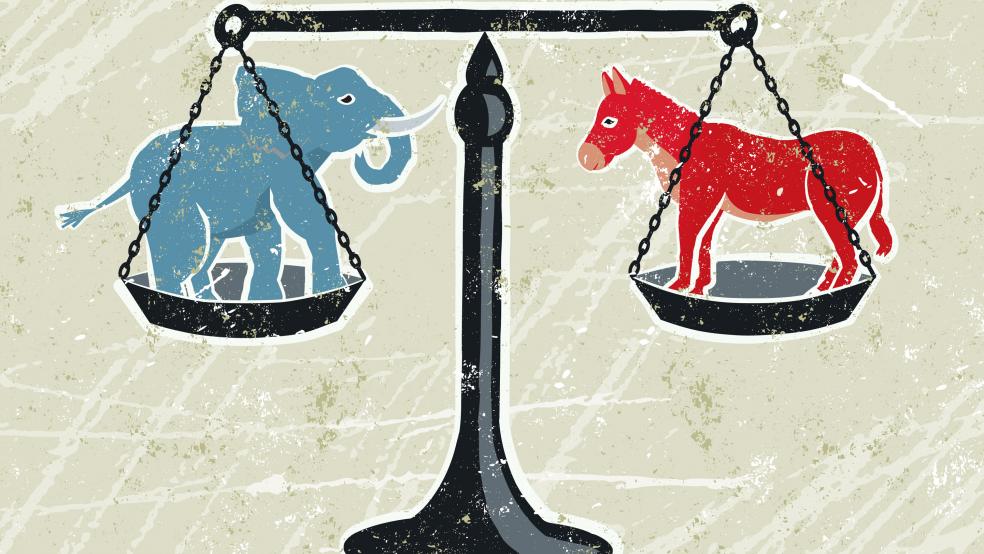A new Gallup poll released on Wednesday shows that the number of Americans identifying with the Republican Party has fallen to a record low of 25 percent. This revelation comes just months after another Gallup survey found that a mere 28 percent of the electorate had a favorable impression of the GOP – the lowest such rating measured for either party since Gallup began asking the question in 1992.
The GOP’s latest loss in party followers translated into a solid gain for independents, who are pressing for campaign reforms to give them a bigger say in the 2016 presidential primary elections. Forty-two percent of Americans, on average, identified themselves as political independents in 2013; the highest Gallup has measured in a quarter century.
Related: GOP Sees Plenty of Options on UI ‘Pay-Fors’
If these findings are accurate – and some prominent political analysts are disputing them – they represent further troubling developments for a party that suffered a major setback in the 2012 presidential election largely because of a narrow political base and flagging party enthusiasm.
These trends may also help to explain why some GOP leaders have begun moderating their rhetoric and tailoring their agendas to try to appeal more broadly to lower and middle income voters and urban areas.
For example, Sen. Marco Rubio (R-FL), House Majority Leader Eric Cantor (R-VA), House Budget Committee Chairman Paul Ryan (R-WI) and others have begun outlining proposals for sparking economic growth, assisting the poor and revitalizing urban centers such as Detroit. Republican Ohio Gov. John Kasich has expanded Medicaid coverage and has urged fellow Republicans not to use votes on poverty issues as a conservative litmus test.
The apparent deterioration in allegiance to and approval of the GOP could also have important consequences for Republicans in the 2014 mid-term elections and beyond. The GOP needs to pick about a half-dozen seats to capture control of the Senate this fall, but those efforts could be hampered unless Republicans figure out a way to staunch the apparent defections.
Related: Energy Lobby Fired Up About 2014 Elections
“The increased independence adds a greater level of unpredictability to this year’s congressional midterm elections,” Gallup said in its analysis. “Because U.S. voters are less anchored to the parties than ever before, it’s not clear what kind of appeals may be most effective in winning votes.”
Candidates who are less closely aligned to their party or its prevailing doctrine may benefit from that, according to Gallup.
University of Virginia political scientist Larry Sabato offers a counter view, arguing that President Obama’s low approval ratings, voter nervousness about their personal finances and the quirkiness of the electoral playing field this year point to GOP gains in both the House and Senate. “At this early stage, the combination of these three factors suggests a good election year for the GOP,” he wrote this week in Politico.
Republicans were hurt more than Democrats were by voter shift to independent status, according to the Gallup survey. GOP identification peaked at 34 percent in 2004, the year Republican George W. Bush won his second term as president. Since then, it has fallen nine percentage points, with most of that decline occurring during Bush’s second troubled term.
Voter identification with the GOP has declined or stagnated ever since. It improved only slightly to 29 percent during the Republicans’ trouncing of the Democrats in the 2010 congressional elections.
Gallup says the surge in interest in the independent movement occurred in the last quarter of 2013, right around the time of a 16-day government shutdown that was sparked by Republican efforts to dismantle the Affordable Care Act. At least 40 percent of Americans have identified themselves as independents in each of the past three years.
Voter identification with the Democrats has also declined in recent years, according to Gallup, falling five points from its most recent high of 36 percent in 2008 – the year President Obama won his first term. The current 31 percent of Americans identifying with Democrats matches the lowest annual average in 25 years.
Related: Why the GOP Will Survive Its Lousy Poll Numbers
However, about 16 percent of self-identified independents say they lean Democratic, just as another 16 percent say they lean Republican. All told, 47 percent of Americans identify with or lean towards the Democrats while 41 percent identify with or lean towards the Republicans.
Not everyone agrees with Gallup’s overall assessment. Sabato yesterday dismissed Gallup’s findings as “ridiculous,” while Emory political scientist Alan Abramowitz is preparing his own refutation of the Gallup poll results.
“Gallup is saying that there has been a sudden surge of independents and that this is making the 2014 elections highly unpredictable,” Sabato told The Fiscal Times. “It's balderdash.”
Here is Sabato’s rejoinder: “First, most other surveys don't show the same phenomenon. Look at the Pollster.com averages that indicate there were far more independents in early 2012 than now . . . and what happened in November 2012 was one of the most partisan elections in decades.”
“Second, the proportion of self-defined independents varies a lot depending on the exact question wording and poll methodology. Third, reams of research have shown that the vast majority of self-defined independents are closet partisans who vote just like self-defined Democrats and Republicans. Currently, Gallup's own data demonstrate a huge party divide on Obama, for example, with independents just as divided as partisans.”
Top Reads from The Fiscal Times:




